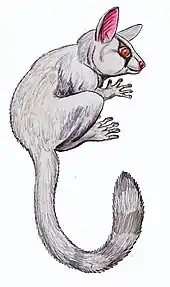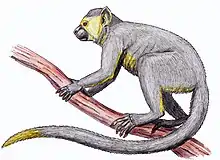| Junzi imperialis Temporal range: Holocene, | |
|---|---|
| Scientific classification | |
| Domain: | Eukaryota |
| Kingdom: | Animalia |
| Phylum: | Chordata |
| Class: | Mammalia |
| Order: | Primates |
| Suborder: | Haplorhini |
| Infraorder: | Simiiformes |
| Family: | Hylobatidae |
| Genus: | †Junzi Turvey et al., 2018 |
| Species: | †J. imperialis |
| Binomial name | |
| †Junzi imperialis Turvey et al., 2018 | |
Junzi imperialis is an extinct species of gibbon that was found in an Ancient Chinese noblewoman's tomb. The type species, based on an incomplete skull, was named Junzi imperialis in 2018 by Samuel Turvey and colleagues.[1] It is believed that when alive, during the Warring States period around 2,200 to 2,300 years ago, the type specimen was owned by Lady Xia, the mother of King Zhuangxiang of Qin and grandmother of Qin Shi Huang, the first emperor of China.[2]
Discovery and naming
The holotype skull was discovered when the tomb was opened in 2004. The living animal is thought to have been a member of Lady Xia's menagerie of luxury pets, which also included cranes,[2] leopards, lynxes, and a black bear.[3]
The generic name was coined by Turvey and his colleagues in reference to how gibbons were, in ancient China, kept by noblemen scholars, or junzi (君子), as pets.[2]
References
- ↑ Samuel T. Turvey; Kristoffer Bruun; Alejandra Ortiz; James Hansford; Songmei Hu; Yan Ding; Tianen Zhang; Helen J. Chatterjee (2018). "New genus of extinct Holocene gibbon associated with humans in Imperial China" (PDF). Science. 360 (6395): 1346–1349. Bibcode:2018Sci...360.1346T. doi:10.1126/science.aao4903. PMID 29930136.
- 1 2 3 Gabbatiss, Josh (21 June 2018). "New species of extinct ape discovered in tomb of ancient Chinese noblewoman". The Independent. Retrieved 22 June 2018.
- ↑ Briggs, Helen (21 June 2018). "Mystery extinct ape found in ancient Chinese tomb". BBC News. Retrieved 22 June 2018.



